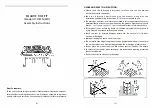
15.
Hot air outlets must not be located at areas with materials susceptible to structural changes caused by
temperature fluctuations (e.g. polyester lining, certain types of wallpapers etc.)
16.
No construction changes or adjustments may be performed on the fireplace insert!!!
All local regulations, including regulations concerning national and European standards. Have a specialized
project elaborated before construction.
The project documentation must be elaborated in a scale of
1:10
or
1:20
. Before the fireplace enters
operation, it must be inspected by a chimney sweeper and the exhaust path must be inspected in accordance with
Chapter 9 of ČSN 73 4201/2016 ed.2.
Inspection of the flue pipe connection to the insert and chimney vents
should be performed before closing the exhaust path to the hot air chamber.
The result of the inspection shall be
recorded in the exhaust gas inspection report including the technical report according to Decree No. 34/2016
Coll.
Please keep the Revision Report and the Technical Report carefully!
Vertical cross section of single-coating fireplace with closable furnace
Figure 2
01 – chimney vent
11 – air intake from other rooms (or CAI)
02 – wall
12 – ventilation of ceiling insulation areas
03 – insulation area above the chamber
13 – hot air outlet from the chamber
04 – hot air chamber ceiling
14 – heat insulating layer
05 – ventilated air gap
15 - wall of hot air chamber
06 – heat insulating layer
16 – fireplace ledge
07 – hot air chamber area
17 – fireplace ledge protection
08 – fireplace insert flue pipe
18 – air intake for hot air chamber
09 – fireplace insert smoke chamber
19 – air intake from the room to under the fireplace insert
10 – closed fireplace furnace
20 – inflammable floor (pad) in front of the fireplace
21 – CAI throat
A chart of the fireplace set holds in general also for double-coating fireplace inserts and fireplace inserts with
a heat-accumulating and warm water exchanger.
5.
Operation manual
5.1
Fuel
It is only allowed to burn wood in fireplace inserts in accordance with law
No.
201/2012 Coll.
To reach the
nominal parameters of the heater, we recommend using dry logs with a diameter of
5-8 cm
and length of
20-30
cm
and with a humidity below
20%
(ideally
10%
). Oven wood and chopped pieces of wood should be used
only when starting the fire. Recommended humidity can be obtained by storing the chopped logs for at least two
years in a ventilated shelter.
The fireplace insert should be heated to a nominal output stated in the technical sheet, i.e. the burning of a
given amount of allowed fuel per
1 hour
. Long-term excessive output could damage the fireplace stove.
Never use flammable fluids, coke, coal or any of the following types of waste as fuel: chipboards,
plastics, plastic bags, soaked wood or wood-shavings, saw-dust or pellets!
!!!Burning of the abovementioned material not only highly pollutes our environment but also damages
the fireplace insert and the chimney!!!
5.2
Starting the fireplace insert for the first time
Before the first use all remaining stickers must be removed, all accessories must be taken out of the ashpan or
fireplace and the same applies for the transport safety pins.
All plastic cover plugs on threaded connections
are not functional, they are only used for transport.
Check that bulk shutters for directing the draft, chamotte
tiles and the barrier are set correctly (as they might have slipped from their correct positions during transport or
installation). Repair any defects you might find in setting, otherwise the proper functioning of the heater is
endangered. After setting the fireplace insert, connecting it to the chimney and, if need be, connecting the
exchanger to the warm-water set and filling it with a heat-carrying medium, start heating slowly and continue
for at least two hour. Leave the stoves and ashpan doors open (
approx 10-20 mm
) before and during the first
heating in order to prevent the sealing material to mix with the paint. The fireplace insert surface is covered with
heat-resistant paint. During the first heating, after becoming temporarily soft, the paint will eventually become
hardened. During the soft phase the paint surface is more vulnerable to being damaged by a hand or other object.
During the first heating the fireplace insert should be “heated up” with a small flame, burning only a small
amount of fuel with a lower temperature.
The entire process of first putting the product into operation is
done with the maximum opening of the air supply. Therefore, the first two loadings of fuel should
correspond to the bottom limit of the recommended fuel batch (see table "TECHNICAL SHEET“).
All
materials must get used to the heat load. You will prevent cracks in chamotte bricks, damage of the paint or
deformation of the insert materials by a careful first heating.
Following loadings of fuel should then
















































